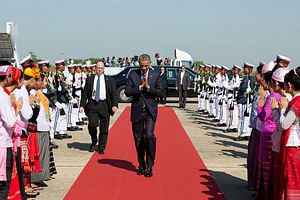Myanmar is located at the crossroads of South and Southeast Asia. It is connected to India and China at its northwest and northeastern borders respectively. Additionally, its reserves of energy resources, emerging consumer class, youthful population, and its access to the Bay of Bengal and Indian Ocean make it an important stakeholder in the Asia-Pacific (and Indo-Pacific) region. Myanmar has figured in the foreign policy discussions of most of its neighbours, including China, India, and the countries of the Association of Southeast Asian Nations (ASEAN). It also factored into the United States’ “pivot to Asia” policy during former President Barack Obama’s administration. To Washington, Myanmar was important both as a member of the ASEAN grouping and as yet another avenue for reducing the influence and dominance enjoyed by China in the region.
Myanmar shares delicate relationships with both China and the United States and has been benefitting from this position for decades. Myanmar’s relations with China have primarily been based on asymmetric power equations, which are proving to be beneficial for Myanmar, at least in the short run. Meanwhile, the improvements in U.S.-Myanmar relations in the first quarter of the 2010s were outcome of the changing geopolitics in the Asia-Pacific, which enabled Myanmar to opt for a balance in its external relations (and sometimes, even mild hedging) with China. A brief historical overview of the recent past helps to understand these specifics.
China took advantage of Myanmar’s political isolation and the economic sanctions imposed by other countries in the wake of the August 8, 1988 democratic uprising and the junta’s rejection of the 1990 general elections results. While the United States and its Western allies criticised Myanmar’s military for its authoritarian rule, China supported the pariah state. China assured the junta rulers about its support for de-escalating ethnic tensions across the Sino-Myanmar borders and maintaining peace and stability.
However, at the same time, China allegedly maintained connections with some of the ethnic rebels including the Wa, the Kachin, and the Kokang insurgents. As the rulers of Myanmar became more aware of this dual position taken by the Chinese, a section of the Tatmadaw started exploring options to deal with China, keeping in view the national interests of the country. The frequent border clashes between the Tatmadaw and the ethnic rebellions on the Sino-Myanmar borders added to this tension.
Meanwhile, U.S.-Myanmar relations were unfolding along a different trajectory A milestone in that relationship came in 2003, when the United States passed the Burmese Freedom and Democracy Act (BFDA). The act imposed strict sanctions on Myanmar and the the Tatmadaw after an alleged attack by the military on Aung San Suu Kyi at Depayin. The BFDA was harsher and harder than the previous sanctions. It resulted in a serious jolt to U.S.-Myanmar trade, especially in the textile sector, and badly affected Burmese textile workers, many of whom were women.
However, the Obama administration decided to review U.S. policy toward Myanmar in 2009. This policy shift reflected that Washington was willing to put more emphasis on unfolding the geostrategic importance of Myanmar in the context of Asia-Pacific region rather than focusing exclusively on Myanmar’s domestic politics. During this period several high-level visits and a number of high-level meetings happened between both the countries. Myanmar, however, was skeptical about this sudden change in U.S. policy, at least initially.
However, Myanmar appreciated Senator Jim Webb and then-Assistant Secretary of State for East Asian and Pacific Affairs Kurt M. Campbell’s ideas about pragmatic engagement with Myanmar. The lifting of U.S. sanctions on Myanmar and restoration of normal diplomatic relations thus began after the 2012 by-elections.
Around the same time, with the suspension of the Chinese funded Myitsone dam, Myanmar seemed to be applying a mild hedging policy vis-à-vis China. Given the context of power asymmetry between China and Myanmar, Chiung-Chiu Huang argues that Myanmar’s approach to the relationship can be understood through the prism of a “balance of relations” that aims at “self-restraint.” Myanmar seeks to manage insecurity and ambiguity, maintain relations with the major powers, and work toward balancing various “external influences.”
In order to understand the impact of the Sino-U.S. strategic competition in the region a few crucial factors about Myanmar need to be remembered. First, Myanmar does not have any territorial disputes with China. Second, the country aspires to benefit from the Chinese infrastructure and energy projects (including Kyaukpyu Exclusive Economic Zone and oil and gas pipelines or, more recently, the much discussed China-Myanmar Economic Corridor), especially because Chinese investments do not carry any preconditions about human rights or democratic principles.
This is even more important for Myanmar’s government in the context of the security situation in Rakhine state and the Rohingya refugee crisis, as China actively supports Naypyidaw’s stance on this particular issue. China has on many occasions prevented the United Nations from passing any resolution against Myanmar addressing the latter’s record of human rights violations. Most recently, in October 2018, China even tried to stop the UN Fact Finding Mission from reporting to the United Nations Security Council on the Rohingya crisis. China has always maintained that the international community needs to restrain itself from interfering in the domestic affairs of Myanmar. The policy of noninterference in the domestic affairs of other countries has been a critical factor in shaping the special relationship between China and Myanmar.
Hence, Myanmar will continue to maintain the Pauk Phaw (fraternal relationship) with China even as the U.S.-China competition heats up. This actually serves Myanmar’s long-held foreign policy, which calls for balancing internal factors while managing external relations independently.
Naypyidaw will remain a hotspot for competition between the China and the United States. Based on the recent past, Myanmar will benefit from maintaining a delicate balance in its external relationships.
Dr. Sampa Kundu is an Assistant Professor at the Symbiosis School of International Studies, Pune, India.

































